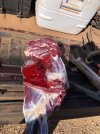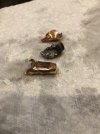Wraith Hunter
Member
When harvesting an animal the size of the animal and the hide makeup are what causes me to choose which weapon I shoot.I have seen this mentioned in several threads lately. My experience has been a gutshot animal with a 338 is just as bad as a gutshot animal with a 243. I am not convinced bigger calibers allow for a materially greater margin of error, especially if you are shooting a berger type bullet or one that expands well. What are y'alls thoughts?
If I were looking to kill an Elk or Deer sized animal I would use a bullet that has considerable hydrostatic shock, .257 Weatherby Mag or .300 Weatherby Mag. However, neither of those two would instantly drop an Elk or Deer if they were gut shot. If I were to hunt an animal with thick skin, such as Elephant, Rhino or Cape Buffalo, I would use a caliber that would penetrate deeply into the target with sufficient terminal energy to cause rapid incapacitation. .460 Weatherby Mag. Again, shot placement is critical.
I believe, in North America, where animal skins are thin and chest cavities are not deep, any caliber with high hydrostatic shock will work. I personally prefer the Weatherby .300 Mag and the Weatherby .257 Mag. My wife made a very low gut shot on a deer with her .257 Weatherby Mag and the deer ran approximately 200 yards before it died.
A few years ago I shot a 410 pound bear with my .300 Weatherby Mag, with a 180 grain SP BT, high the lungs. The bear fell with no additional movement or sound. The hydrostatic shock instantly killed the animal!


